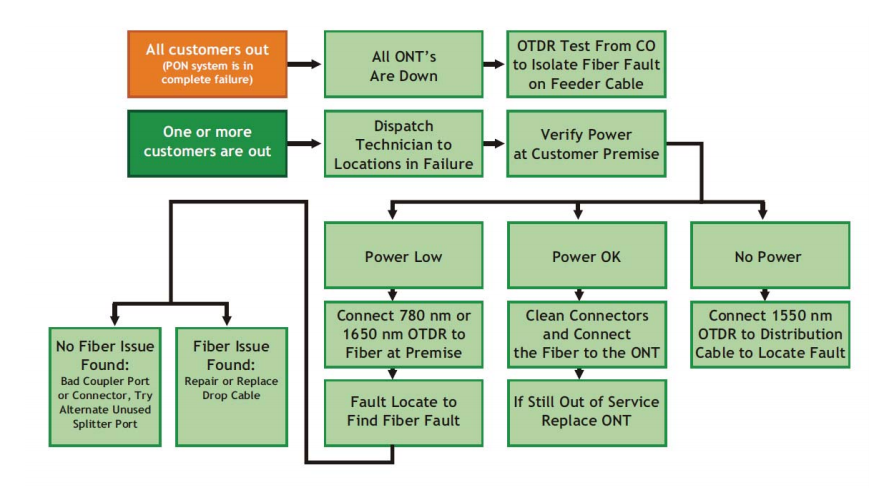PON (Passive Optical Network) architecture is commonly used for FTTx (Fiber to the x, x=home, curb, building…) networks because it employs optical splitters to deliver signals to multiple users without conversion or intervention. This reduces the cost of the system substantially by sharing one set of electronics and an expensive laser with up to 32 terminations. PON troubleshooting is an important part in FTTx installation and maintenance. If all customers connected to a PON system are out of service, testing can proceed at the CO (Central Office) without danger of interfering with existing service. System diagnostics will usually detect a problem with the OLT (Optical Line Terminal) and the solution is normally a line-card replacement. The OLT manager will usually identify a broken fiber on the main leg as all branches associated with the OLT will become nonresponsive. Troubleshooting can then proceed with an OTDR (Optical Time Domain Reflectometer) or a simpler break indicator.
The following picture outlines a methodology for troubleshooting PON networks in the more difficult situation where one or some customers connected to the PON are out of service. When a fault occurs in the subscriber’s FTTH service, if other subscribers sharing the OLT are not experiencing the same fault, then the problem is either in the drop cable between the FDH (Fiber Distribution Hub) and the ONU/ONT (Optical Network Unit / Optical Network Termination), in the ONU/ONT or in the subscriber’s home network. The technician should begin by disconnecting the optical fiber from the ONU/ONT and checking the optical signal level with a power meter.

If no power is measured on the drop cable, the chances are that the problem is either a break in the fiber or a high loss event such as a bad splice. Since no power is being received at this ONT location, there is no danger of interfering with traffic on the PON when testing the fiber using an OTDR. But to be safe it’s a good idea to troubleshoot with an OTDR using the 1650nm wavelength to avoid interfering with the ONT in the event of a mistake. If the optical power level is lower than the specification, there is a good chance that there is a break or damage in the drop cable. Maintenance of a PON drop cable requires care when the rest of the network is still in service. One approach is to isolate the drop cable under test from the rest of the network but this is not easy because the connections are often high on utility poles and wires, and disconnecting fiber splices is difficult. The solution is to use a short wavelength OTDR with test pulses at a wavelength of 780 nm. Testing from the subscriber’s side at 780 nm has no effect at all on the in-service customers. The dynamic range at 780 nm is 8 dB so faults in a 2 km or shorter drop cable can be accurately pinpointed.
If the power is OK, then test down the stream from the coupler with an OTDR and bare fiber adapter to pinpoint the attenuation.





